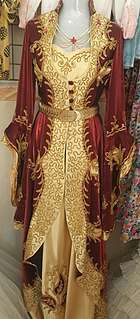Algerian caftan
The Algerian kaftan, or Algerian caftan ( Persian: خفتان الجزایری),[1] is a traditional Algerian garment. It is said that the Ottomans introduced it to Algeria in the 15th century. Throughout history, the Algerian caftan borrowed multiple style elements from various Islamic civilizations and dynasties as a result of the trade and commercial caravans passing through the country. The popularity of the Algerian caftan within the Ottoman Empire rose following the incorporation of several fashionable and feminine style elements. There are a number of types of authentic Algerian caftans, including: "Kaftan Al-Qunfalfa", "Kaftan Al-Bay", "Kaftan Al-Qadi", "Caftan", and "Tlemcenian Intensity".
History

A Caftan is a traditional piece of clothing worn by women in Algeria,[2] mainly being worn at events and weddings. The Algerian caftan industry has witnessed great growth and increasing demand in recent years, after caftans appeared at numerous forums and fashion shows, which introduced the garment to western fashion designers such as: Balmain, Yves Saint Laurent, John Paul Gaultier, and others who rushed to include improved versions of it in their catalogs. The caftan, which is one of the most important aspects of Algerian culture in the field of heritage clothing, came from the borders of Algeria to the countries of the world, finding its way into the fashion world and adoption by the most important international fashion brands, and to be worn by celebrities and world figures. The history of the caftan reflects the love of Algerians, their appreciation for beauty, and their ability to preserve a historical legacy within a society through different periods and civilizations.
The spread of the Caftan in its well-known form today dates back to the era (1244-1465 AD) from Algeria to the Arab Maghreb where it was distinguished by design, embroidery and simple colors. Wearing the Caftan was restricted to princes and sultans only and it would later be available to the public during the era of the Ottomans. It became more famous and popular among Algerians, and most women in Algeria wear it today. Some historians believe that the spread that the caftan enjoyed to countries around the world happened at an earlier date, perhaps as early as the beginning of the ninth century; they ascribe it to the rulers of Algeria who were famous for their elegance and careful choice of color.
Despite the audacity of Algerian and Western fashion designers in adding modern touches to the caftan, which contributed to its development and spread globally, it remains preserved in its traditional form through the guardians of this heritage of craftsmen and ancient designers. They deal with great caution with the development of this dress and the addition of new touches to its designs, for fear of losing its legacy, as it represents the Algerian cultural and historical heritage. Besides this, the caftan makes an important contribution to the state treasury; the constant interest of Algerian designers in developing the caftan made it an ambassador for Algerian culture in international forums and fashion fairs, which increased demand for it by figures from different cultures and geographical regions. The caftan contributes 16% of the exports of Algerian traditional industries.
The origin of the caftan

The caftan has been known since ancient times as a garment in various different regions of the world including Central Asia, Persia (Iran), India when it was occupied by the Mongols, Venice and the Ottoman Kingdom (Turkey). Until the Umayyad era, the caftan was a cloak or a long jacket worn over the dress of the period, and was clothing intended for men only. Most types of kaftans share details, such as that they are long, with long, wide sleeves that reach the elbow, and are with or without buttons.
Every region or country has added touches that distinguish the caftans of its region, introducing novel fabrics, colors, embroidery and ornaments, and from here the Persian, Turkish, and Mongolian caftan appeared.